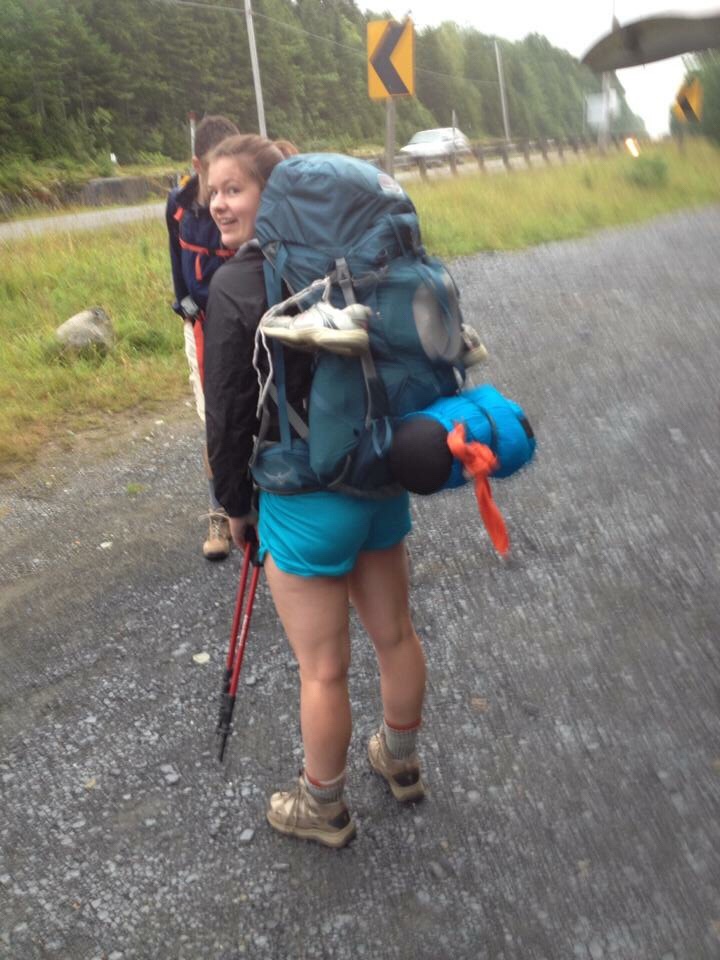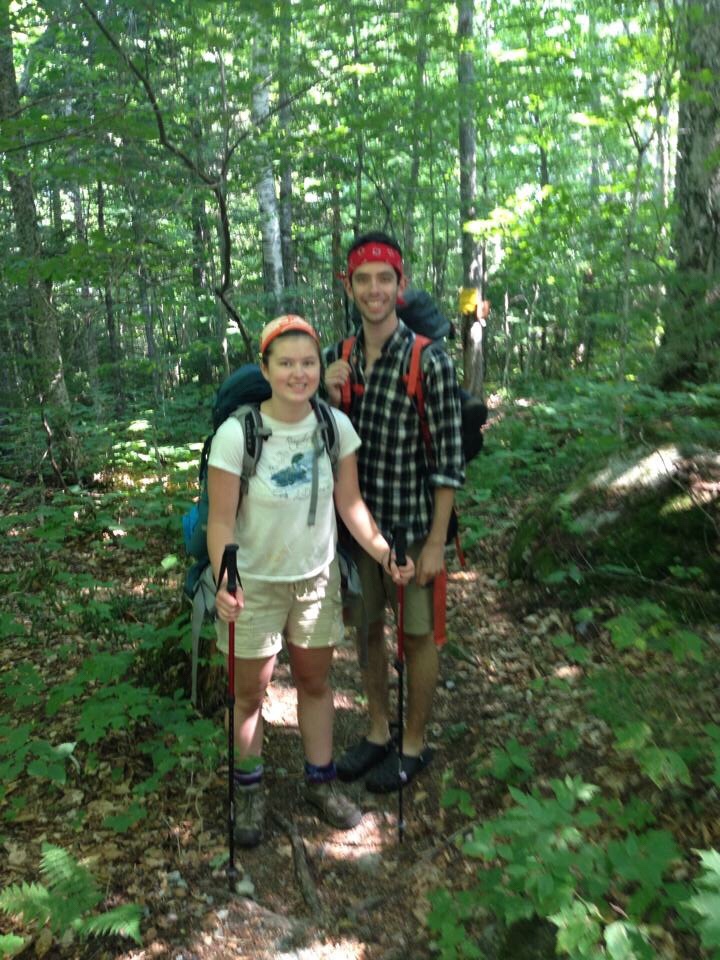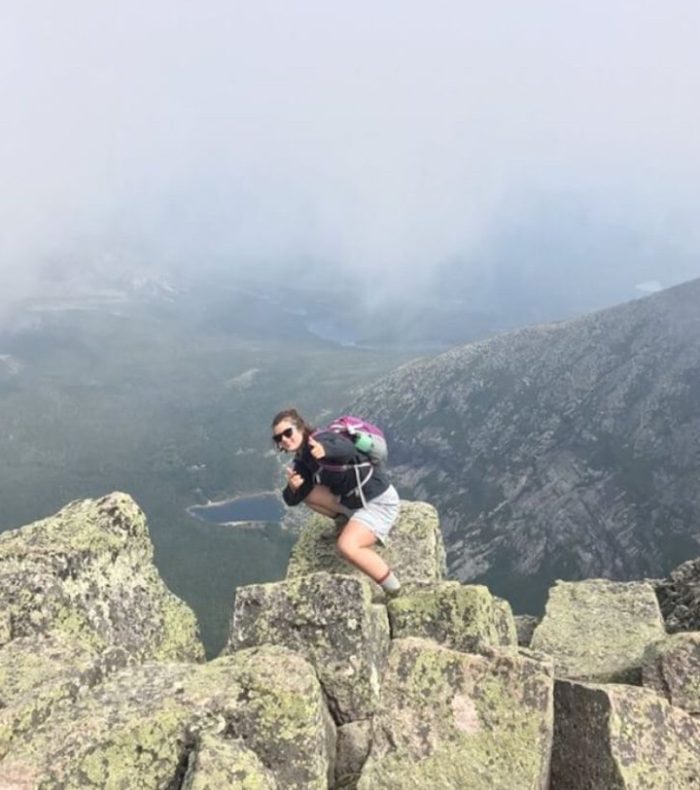How to Convince Your Body It Can Walk 2,000 Miles
The summer before I started college my brother and I planned to hike Maine’s 100-Mile Wilderness. It was the first time we’d carried our own gear on a multiday trip (we’d done a couple of overnights before, but our mom had always slackpacked us). My pack weighed in at 36 pounds at the start of the trip. We had no idea what to expect, carrying three times as much fuel for our stove as we actually used, but going without sleeping pads. This photo was taken minutes before we set off, my pack comically overstuffed with clean clothes and sadly lacking many necessities. To this day, I have no idea why I elected to bring an extra pair of sneakers.

Pre-hike. Note the sneakers tied to the outside of my pack. Why?
I can’t speak for Abe, but I can certainly say that my fitness level was subpar and every mile was a struggle. We got caught in thunderstorms on open ridges, were perpetually wet, and had to get picked up on a logging road halfway through because we just couldn’t hike enough miles each day to make it to the end. It was the best week of the summer.
The next year, we went back and finished what we’d started, ending at the foot of Katahdin, which we’d climbed several times. The year after that, I hiked solo from Monson to Carrabasset, and I’ve finished many more sections of Maine’s AT on day hikes. I’m happy to say that both my fitness and my knowledge of what to bring along have made significant progress since the day we set off from Route 15.

Coming off the trail on our first attempt at the 100-Mile Wilderness in August 2014.
The Best Way to Train for a Hike Is to Hike
That’s the message I’ve heard again and again, from anybody I’ve asked. Unfortunately, as a college student working 35 to 40 hours a week to save for a thru-hike, it’s pretty difficult to find time to hike, or gas money to get to a mountain. Couple that with Maine’s cold winters and short days, and I’ll admit that I haven’t gotten out as much as I’d like to. I’m lucky to live near a wildlife preserve, where I frequently snowshoe on the mornings when I don’t have to be at work before dawn, but until I’m able to hit the mountains, most of my physical prep is happening in a gym.

On top of Katahdin, August 2017.
My Current Training Schedule
I joined a CrossFit gym in December 2016 as a way to keep fit when rugby season ended. Ever since, I’ve learned to love working out when it used to be a chore (shout out to the awesome CFB coaches and my gym buddies who always keep me motivated) and become really passionate about fitness. CrossFit is an integral part of my thru-hike training. I’m trying to stick with hitting the gym four to six days a week, and I’m already seeing the progress I’ve made since starting that schedule.
My motto when it comes to working out is “put a barbell in my hands and I’m happy.” I’ll take exhausting lifts like thrusters over burpees or biking any day. However, when it comes to thru-hike prep, my main focus is my aerobic capacity. I’m still putting in the work on strength training, but I know that I’ll get winded a lot sooner than my legs will start feeling like jelly when I hike, so I’m putting in the work to be proactive about that problem.
I work at a fitness center, and it’s undeniably convenient for me to get in some cardio on my breaks, or stick around for an hour after my shift to get in an extra workout. I’m putting in a lot of time running on a treadmill with a significant incline and hitting the Stairmaster because these seem the closest to hiking out of the options I have available. I’m trying to fit this in at least two or three times a week, more if I have time.
Getting Used to the Weight of a Pack
Next time I visit my parents, I’m planning to pick up my hiking gear. My pack and all the other gear they’ll be happy to have out of their basement will be coming back up to school with me. Shakedown hikes won’t be in the cards for quite a while, but walking to work with a full pack and keeping it on through my after-work cardio will definitely help me get used to it. I’m not worried about my ability to carry a full pack, but I am worried about taking a fall or twisting an ankle as I get used to a different center of gravity. If I get my body used to the feeling of wearing a pack before I even start my hike, I’m hoping I’ll cut out a lot of opportunities to hurt myself on the trail.

We’ll See If Any of This Works
I’m 100 percent sure that I’m in much better shape now than I have been on any previous hiking trip. That being said, there’s still a part of me that wonders if I’m doing enough. Since my first failed attempt at the 100-Mile Wilderness, I’ve reached the point where I can knock out 15- to 20-mile days with a full pack, but starting my hike on terrain I’ve never seen before is definitely a scary prospect to me. How do I know that I’m not going to encounter something in Georgia that I don’t know how to deal with? There’s nothing I can do about that feeling but keep working hard until I start my hike in May and hope for the best, but I’m itching for warm weather so I can hit the trail and get a feel for how much progress I need to make.

Bigelow will always be my favorite hike in Maine.
This website contains affiliate links, which means The Trek may receive a percentage of any product or service you purchase using the links in the articles or advertisements. The buyer pays the same price as they would otherwise, and your purchase helps to support The Trek's ongoing goal to serve you quality backpacking advice and information. Thanks for your support!
To learn more, please visit the About This Site page.


Comments 1
Rose, sounds like you got one of the most important aspects of thru-hiking taken care of – a strong base-level of fitness. Keep it up!